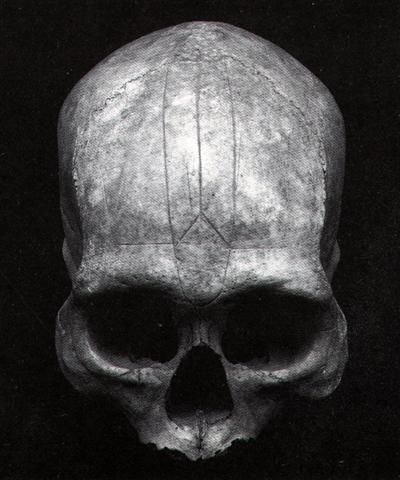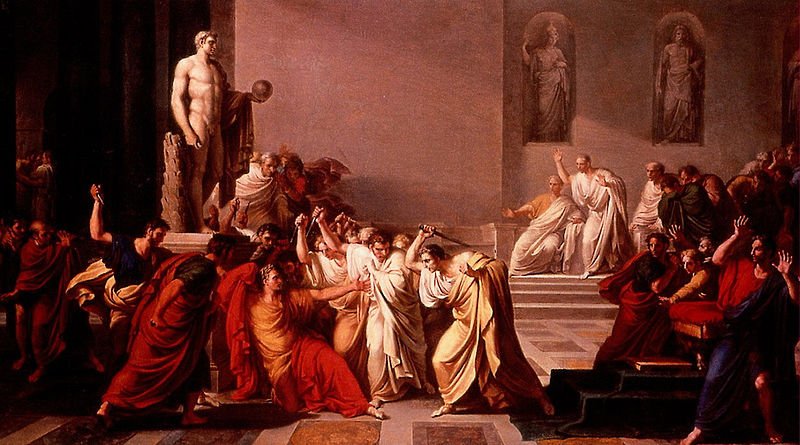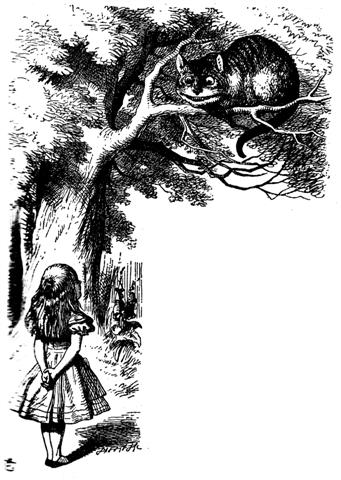10-2. A kind of 'head' from where to
begin to 'weave the kupega net' was evidently located at the
beginning of side b of the E tablet:
... Up to the present time, fertility
spells for fowls have played an important role.
Especially effective were the so-called 'chicken skulls'
(puoko moa) - that is, the skulls of dead chiefs,
often marked by incisions, that were considered a source
of mana. Their task is explained as follows: 'The
skulls of the chiefs are for the chicken, so that
thousands may be born' (te puoko ariki mo te moa, mo
topa o te piere) ... As long as the source of mana
is kept in the house, the hens are impregnated (he
rei te moa i te uha), they lay eggs (he ne'ine'i
te uha i te mamari), and the chicks are hatched (he
topa te maanga). After a period of time, the
beneficial skull has to be removed, because otherwise
the hens become exhausted from laying eggs
...

A 'head' meant the end, and the end marked a new
beginning:
... Another year passed, and a man by the name of Ure
Honu went to work in his banana plantation. He went and
came to the last part, to the 'head' (i.e., the upper part
of the banana plantation), to the end of the banana
plantation ...
|
Oct 7 (280 = 40
weeks) |
8 |
9 (282 → 2 * 141) |
 |
 |
 |
|
Eb1-1 |
Eb1-2 |
Eb1-3 |
|
tagata mau kupega |
te henua |
te maitaki |
|
Kupega. He-tá i te kupega, to
weave (a net). Hopu kupega, those who help
the motuha o te hopu kupega in handling the
fishing nets. Huki kupega, pole attached to
the poop from which the fishing-net is
suspended. Mata kupega, mesh. Te matu'a o
te kupega, part of a net from which the weaving
started. Te puapua kupega, the upper part of
a fishing net. Tau kupega, rope from which
is hung the oval net used in ature fishing.
Tuku kupega, a fishing technique: two men
drag along the top of a fishing net doubled up,
spread out on the bottom of a small cove, trapping
the fish into the net. Vanaga.
Maitaki. Clean, neat, pure, pretty, nice,
beautiful, handsome; tagata rima maitaki,
clean-handed man, correct man. Vanaga. 1. Good.
Henua maitaki = the good earth. 2. Shine.
Marama maitaki = the shining moon. Barthel. Ce
qui est bon. Jaussen according to Barthel.
Meitaki, good, agreeable, efficacious,
excellent, elegant, pious, valid, brilliant,
security, to please, to approve (maitaki);
ariga meitaki, handsome, of pleasant mien;
mea meitaki ka rava, to deserve; meitaki ke,
marvelous, better. Hakameitaki, to make good,
to amend, to do good, to bless, to establish.
Meitakihaga, goodness. PS Pau.: maitaki,
good. Mgv.: meitetaki, beautiful, good. Mq.:
meitai, good, agreeable, fit, wise, virtuous.
Ta.: maitaiki, good, well. Niuē:
mitaki,
good. Maitakia,
clean. Churchill. |
|
CLOSE TO THE FULL MOON: |
|
σ
Virginis (200.4)
*159.0 = *200.4 - *41.4 |
γ
Hydrae (201.0),
ι
Centauri (201.4)
*160.0 = *201.4 - *41.4 |
Al Simāk-12 (Lofty)
/
Chitra-14 (Bright One)
/
Horn-1 (Crocodile)
/
Sa-Sha-Shirū-19 (Virgin's
Girdle)
/
ANA-ROTO-3 (Middle pillar)
MIZAR =
ζ
Ursae Majoris (202.4),
SPICA =
α Virginis,
ALCOR (The Fox) = 80
Ursae Majoris
(202.7)
SADALMELIK (α Aquarii) |
 |
|
INVISIBLY
CLOSE TO THE SUN: |
|
ν
Phoenicis (17.4), κ Tucanae (17.6)
*159.0 + *182.0 = 341.0 |
No star listed (18) |
ADHIL
(Garment's Train) = ξ Andromedae
(19.3),
θ
Ceti (19.7) |
|
April 7 (107 =
280 - 183) |
8 (108) |
9 (109) |
|
FEBR 2 (365 + 33 = 408) |
3 |
4 (45 = 109 - 64) |
When the Full Moon could be observed at
the right ascension line (the 'thong'
→
februa) connecting heaven and earth it could be
deduced that the blinding rays from the Sun simultaneously
had to be at the train of the garment of Andromeda.
Reasonably, it could be imagined, her garment was ending
here and a new star cloth (a net) had to be woven in order
to cover her nakedness. A new spring was ahead.

... The principal word for 'fish' in most
Dravidian languages is min, which has an ancient
homophone meaning 'star', both probably derivatives of the
root min 'to glitter' ... Fish are actually unable to
close their eyes, and the fact that 'when the fish sleeps it
does not close its eyes' was noticed by ancient Indians. The
dot-in-a-circle similar to that occuring among the trefoils
of the Harappan priest-king's robe is identical with the eye
of the many small hare- and fish-shaped amulets discovered
on the lower levels of Harappa ... (Asko Parpola,
The Sky Garment.)
On the Egg tablet (Mamari, E) there are
392 (→ 80 + 312) glyphs on side a and 348
(→ 240 + 108) on side b.
320 + 420 = 740 (→ 640 + 100).
My previous suggestion of *314 at the 'head of the prince'
could in a way refer to the thong which kept heaven and
earth together. We should notice that 80 + *314 = 394
(January 29) = 285 + 109 (April
9).
At the end of January all was still well (maitaki),
but then the 'close embrace' ended and the sky garment broke
apart:
... They were Ranginui, the Sky
Father, and Papatuanuku, the Earth Mother, both
sealed together in a close embrace. Crushed between the
weight of their bodies were their many children, whose
oppression deepened. They yearned to be free; they fought
their parents and each other to break loose. Tuumatauenga,
virile god of war, thrust and shouted; Tangaroa of
the oceans whirled and surged; Tawhirirangimaatea,
Haumiatiketike and Rongomatane, of wild foods and
cultivated crops, tried their best but were not successful;
and Ruamoko, god of earthquakes, yet to be born,
struggled in the confinement of his mother's womb ... Of
them all, Taane Mahuta, the god of the forests, was
the most determined; he set his sturdy feet upon his
father's chest, and braced his upper back and shoulders
against the bosom of his mother. He pushed; and they parted.
So the world, as the Maori understand it, came into being
...
... In South America the rainbow has a
double meaning. On the one hand, as elsewhere, it announces
the end of rain; on the other hand, it is considered to be
responsible for diseases and various natural disasters
[dis-aster]. In its first capacity the rainbow effects a
disjunction between the sky and the earth which previously
were joined through the medium of rain. In the second
capacity it replaces the normal beneficient conjunction by
an abnormal, maleficient one - the one it brings about
itself between sky and earth by taking the place of water
...
|
Oct 10 (→ 80) |
11 |
12 (285) |
13 |
14 |
|
71 VIRGINIS
(203.6) |
No star listed (204) |
HEZE = ζ Virginis
(205.0),
SOUTHERN PINWHEEL GALAXY = M83 Hydrae
(205.7) |
ε Centauri (206.3),
κ Oct. (206.4)
*165.0 = *206.4 - *41.4 |
No star listed (207) |
 |
 |
 |
 |
 |
 |
|
Eb1-4 |
Eb1-5 |
Eb1-6 |
Eb1-7 |
Eb1-8 |
|
te heu |
te inoino |
henua |
te maitaki |
te poporo |
|
Kino. 1. Bad; kikino,
very bad, cursed; kona kino, dangerous place.
2. blemish (on body). Kinoga, badness, evil,
wickedness; penis. Kinokino, badly made,
crude: ahu kinokino, badly made ahu, with
coarse, ill-fitting stones. Vanaga. 1. Bad, wrong. T
Pau.: kiro, bad, miserable. Mgv.: kino,
to sin, to do evil. Mq.: ino, bad,
abominable, indecent. Ta.: ino, iino,
bad, evil; kinoga (kino 1) sin; Mgv.:
kinoga, sin, vice. 2. A skin eruption,
verruga, blotched skin, cracked feet T. Churchill. |
|
April 10 (100) |
11 |
12 |
13 |
14 (104) |
|
KSORA (Knee) =
δ
Cassiopeiae
(20.1),
ω
Andromedae (20.6),
γ
Phoenicis (20.8) |
δ Phoenicis (21.5) |
υ Andromedae (22.9) |
ACHERNAR (End of the River) =
α
Eridani
(23.3),
χ
Andromedae (23.6),
τ
Andromedae (23.9) |
ALSEIPH (Scimitar) =
φ
Persei
(24.5),
τ
Ceti (24.7) |
 |
|
'March 14 |
15 |
16 |
17 |
18 (104 - 27 = 77) |
|
... I
became interested in what really
happened at March 15 and reopened
Henrikson to find out: Caesar was
forewarned of the threat by the prophet
Spurinna, who told him that a great
threat was coming at Idus
Martiae or just before. The day
arrived and Caesar was still living. He
was walking to his meeting with the
Senate when he happened to encounter
Spurinna and told him jokingly that he
was still alive. Spurinna calmely
answered that the day had yet not ended.
The Romans divided their months in two
parts and the dividing point was Idus,
which in some way was connected with
full moon. March 15 was the midpoint of
March, which is close to spring equinox.
The old agricultural year defined the
beginning of the year to the time when
sun returned, and it was connected with
Mars ...
 |
|
"Febr 28 (59) |
"March 1 (60) |
2 |
3 |
4 (104 - 41 = 63) |
|
FEBR 5 (36) |
6 |
7 |
8
(414 → Bharani) |
9
(104 - 64 = 40) |
|
...
On February 9 the Chorti Ah K'in,
'diviners', begin the agricultural year.
Both the 260-day cycle and the solar
year are used in setting dates for
religious and agricultural ceremonies,
especially when those rituals fall at
the same time in both calendars. The
ceremony begins when the diviners go to
a sacred spring where they choose five
stones with the proper shape and color.
These stones will mark the five
positions of the sacred cosmogram
created by the ritual. When the stones
are brought back to the ceremonial
house, two diviners start the ritual by
placing the stones on a table in a
careful pattern that reproduces the
schematic of the universe. At the same
time, helpers under the table replace
last year's diagram with the new one.
They believe that by placing the cosmic
diagram under the base of God at the
center of the world they demonstrate
that God dominates the universe. The
priests place the stones in a very
particular order. First the stone that
corresponds to the sun in the eastern,
sunrise position of summer solstice is
set down; then the stone corresponding
to the western, sunset position of the
same solstice. This is followed by
stones representing the western, sunset
position of the winter solstice, then
its eastern, sunrise position. Together
these four stones form a square. They
sit at the four corners of the square
just as we saw in the Creation story
from the Classic period and in the Popol
Vuh. Finally, the center stone is placed
to form the ancient five-point sign
modern researchers called the quincunx
...
 |
The denomination 71 Virginis might have been inspired
from the equation 513 (365 + 148) + 71 =584 (synodic cycle
of Venus).

|








